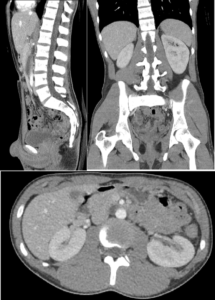Module Introduction through Lumi
Hello!
I am designing a blended learning course for adult learners to refresh and strengthen their knowledge of CT anatomy (also called cross-sectional anatomy). This means finding anatomical structures on images that were acquired with a CT scanner. Looking at images this way is quite different than what we think of as regular X-rays. I am using the LMS Canvas which has impressed me with its clean, simple, intuitive design and has many of the features of robust LMS. I organized the course content into modules, and embedded H5P content created in Lumi. The first couple of modules of this course focus on refreshing the learner’s knowledge of CT images and 2D radiographs. Being comfortable with orientating oneself to the various views available and understanding anatomical directional terms that are used to describe locations provides a strong foundation for learning cross-sectional anatomy.
I am using the LMS Canvas which has impressed me with its clean, simple, intuitive design and has many of the features of robust LMS. I organized the course content into modules, and embedded H5P content created in Lumi. The first couple of modules of this course focus on refreshing the learner’s knowledge of CT images and 2D radiographs. Being comfortable with orientating oneself to the various views available and understanding anatomical directional terms that are used to describe locations provides a strong foundation for learning cross-sectional anatomy.
After the foundation is set, subsequent modules focus on identifying anatomical structures within the different body cavities. Each module will cover a different body cavity: thorax, abdomen, and pelvis. By the end of the course, the learners should have a solid understanding of cross-sectional anatomy. The learners will be able to explain the significance of this knowledge as it is applied to Image Guided Radiation Therapy, which I discussed in my course profile post.
All the didactic learning and assessment will be delivered online with weekly synchronous “class meetings”. This is a flipped classroom model, where the weekly class meetings will provide some context for the didactic material. I divided the course into weekly sections, and then put each week of work into its module. Completing one module each week should help the students group the learnings and help with retention. When designing the modules, I aimed to have each of them a copy of themselves to keep the structure simple and predictable. Each module includes a course presentation which includes the didactic information in the form of an interactive video, some activities to reinforce the learning (instant feedback), and an assignment worth a small number of marks. I included the assignment at the end of the course presentation so that the learners see it right away and they do not need to click around inside the LMS to access it. I will encourage collaboration on these written assignments, as they usually do anyway. Each module will contain the course presentation, an assignment, a short quiz (to show independent learning), and a weekly discussion. An exception is Module 1 which contains two course presentations. Module 1 Session A and Module 1 Session B can be viewed by clicking these links. After our readings last week, I have realized the importance of building community inside the virtual classroom. I have also witnessed this happen with this class, as we communicate with each other via Discord. Elements to the class that I will add to foster community are collaboration on assignments and discussion boards, providing a forum for a Q&A space as Katia did for us, and encouraging discussion in our weekly synchronous class meetings. We will also have weekly lab sessions when we meet together within the clinical environment to practice the image-matching software.
Working within Lumi was a fun yet time-consuming process. This is my first exposure to H5P, so a little research beforehand was also required. I loved the creativity involved, yet learning this new platform and its limitations took more time than I would have expected. I am still unsure if I completely understand, and I put a lot of things down to “user error”. I look forward to feedback from the class about the 2 Lumi Course Presentations created for my course prototype.
Hi there! I can’t seem to open Module 1 Session A (I’m not sure why?) – but Session B looks great at first glance! Lots of great images, great video, great questions!
Hi Lauren, thanks for letting me know. I was concerned this would happen. Whenever I posted the link it worked the first time, then not again. The last time I posted it, it worked twice so I was hoping the problem resolved itself. (lol- I know. Relying on things to resolve themselves, is never a good idea).
I will repost the link again.
Actually, I just tried it again right now and it worked….. sigh. I am not sure what to say
I just realized that it DOESN’T work if I try to access the video from eci834.ca. BUT, if I go directly to your blog, then it works. Something lost in translation I guess? Videos are great though – I really like how you combined the presentation with the interactive video. Best of both worlds. Well done!
Hi Crystal,
I completely agree with you! H5P’s are quite time-consuming. I find that the more I use them, the more comfortable I got with implementing them in my courses. With that being said, I still find that they are time-consuming!
I enjoyed learning about the course you are creating. I liked how for each module, you have a presentation, assignment, quiz and a discussion. Students know exactly what is expected of them and how they will be evaluated.